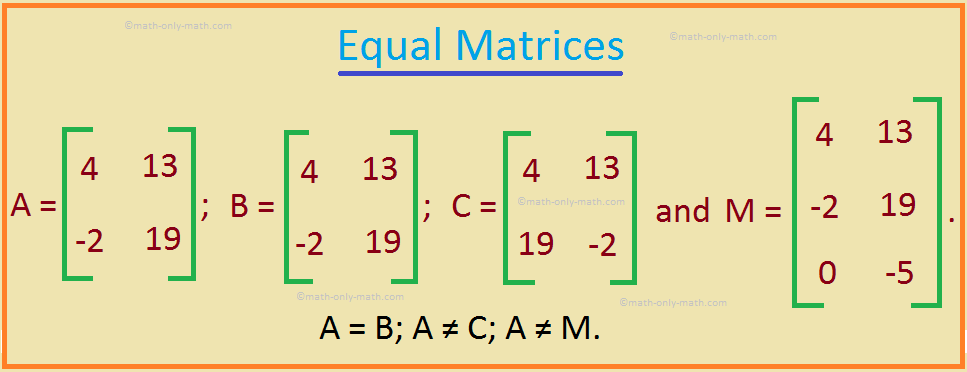Subscribe to our ▶️ YouTube channel 🔴 for the latest videos, updates, and tips.
Home | About Us | Contact Us | Privacy | Math Blog
Equal Matrices
Equality of two matrix: Two matrices [aij] and [bij] are said to be equal when they have the same number of rows and columns and aij = bij for all admissible values of i and j.
Definition of Equal Matrices:
Two matrices A and B are said to be equal if A and B have the same order and their corresponding elements be equal. Thus if A = (aij)m,n and B = (bij)m,n then A = B if and only if aij = bij for i = 1, 2, 3, ....., m; j = 1, 2, 3, ......., n.
The number of rows in matrix A = The number of rows in matrix B and The number of columns in matrix A = The number of columns in matrix B
Corresponding elements of the matrix A and the matrix B are equal that is the entries of the matrix A and the matrix B in the same position are equal.
Otherwise, the matrix A and the matrix B are said to be unequal matrix and we represent A ≠ B.
Two matrices are called equal if and only if
(i) they are of the same order, i.e., the number of rows and the number of columns of one are same as those of the other, and
(ii) corresponding elements are equal, i.e., elements in the same position in both are equal.
For example:
Let
(i) A = B because A and B are of the same order, 2 × 2, and corresponding elements are equal. [Here, (1, 1)th element = 4 in both, (1, 2)th element = 13 in both; (2, 1)th element = -2 in both and (2, 2)th element = 19 in both.]
(ii) A ≠ C because corresponding elements are not equal. [Here, (2, 1)th element of A = -2 but (2, 1)th element in C = 19.]
(iiI) A ≠ M because they are not of the same order. [Here, A is a 2 × 2 matrix while M is a 3 × 2 matrix.]
Examples of Equal Matrices:
1. The matrices A = [5] and B = [5] are equal, because both matrices are of the same order 1 × 1 and their corresponding entries are equal.
2. The matrices A = [2731] and B = [2731] are equal, because both matrices are of the same order 2 × 2 and their corresponding entries are equal.
3. The matrices A = [46125970−3] and B = [46125970−3] are equal, because both matrices are of the same order 3 × 3 and their corresponding entries are equal.
4. The matrices A = [2−165543−37−7952384] and B = [2−165543−37−7952384] are equal, because both matrices are of the same order 4 × 4 and their corresponding entries are equal.
From Equal Matrix to HOME PAGE
Didn't find what you were looking for? Or want to know more information about Math Only Math. Use this Google Search to find what you need.
Recent Articles
-
Worksheet on Area, Perimeter and Volume | Square, Rectangle, Cube,Cubo
Jul 25, 25 12:21 PM
In this worksheet on area perimeter and volume you will get different types of questions on find the perimeter of a rectangle, find the perimeter of a square, find the area of a rectangle, find the ar… -
Worksheet on Volume of a Cube and Cuboid |The Volume of a RectangleBox
Jul 25, 25 03:15 AM
We will practice the questions given in the worksheet on volume of a cube and cuboid. We know the volume of an object is the amount of space occupied by the object.1. Fill in the blanks: -
Volume of a Cuboid | Volume of Cuboid Formula | How to Find the Volume
Jul 24, 25 03:46 PM
Cuboid is a solid box whose every surface is a rectangle of same area or different areas. A cuboid will have a length, breadth and height. Hence we can conclude that volume is 3 dimensional. To measur… -
Volume of a Cube | How to Calculate the Volume of a Cube? | Examples
Jul 23, 25 11:37 AM
A cube is a solid box whose every surface is a square of same area. Take an empty box with open top in the shape of a cube whose each edge is 2 cm. Now fit cubes of edges 1 cm in it. From the figure i… -
5th Grade Volume | Units of Volume | Measurement of Volume|Cubic Units
Jul 20, 25 10:22 AM
Volume is the amount of space enclosed by an object or shape, how much 3-dimensional space (length, height, and width) it occupies. A flat shape like triangle, square and rectangle occupies surface on…






New! Comments
Have your say about what you just read! Leave me a comment in the box below. Ask a Question or Answer a Question.